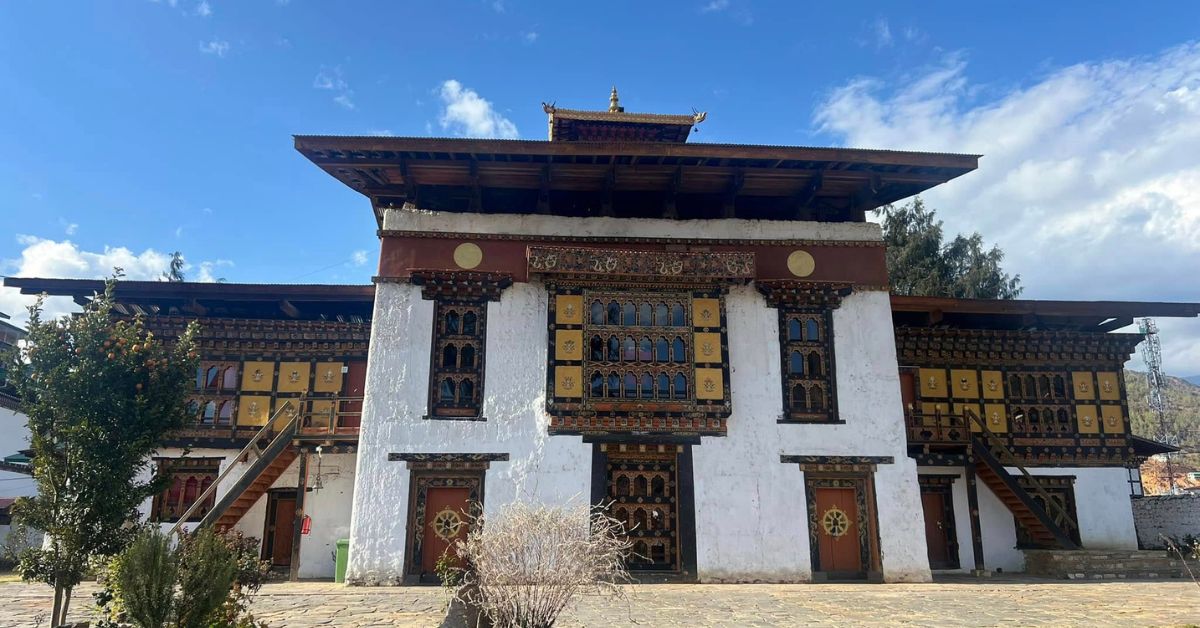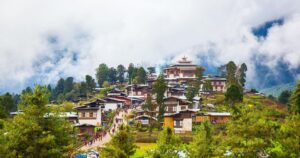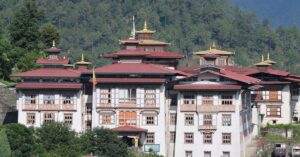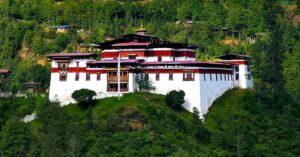Druk Choeding Lhakhang, also known as Tshongdue Temple or Tshongdoe Naktshang, is a two-story temple built by Lama Ngawang Chhogyal in 1525. The temple is located in the heart of Tshongdue town, near Hungrel Dzong in Paro. It is also called Druk Kargyud Choeding Lhakhang.
Tshongdoe Naktshang is renowned for its richly painted walls, which depict the life of the Buddha, along with intricate wood carvings and statues that showcase Bhutanese artistic craftsmanship. The future Buddha, Jowo Jampa statue, is the main relic of Tshongdoe Temple.
Druk Choeding played a pivotal role in Bhutanese history, serving as a residence for Zhabdrung Ngawang Namgyal, and remains a vibrant center of spirituality and culture today.
How To Reach Druk Choeding Lhakhang
Druk Choeding Lhakhang is located in Tshongdu, the heart of Paro town. It is easily accessible for both locals and tourists. If you are staying anywhere in Paro, you can reach the temple by walking or taking a short taxi ride. The temple is centrally situated and close to the main market and other town attractions.
Sacred Relics to See at Druk Choeding Lhakhang
- Jowo Jampa (future Buddha) statue;
- The three Buddhas;
- Statue of founder, Ngawang Chogyal;
- Statues of Zhabdrung Rinpoche and Avalokiteshvara;
- Kanjur and Tenjur;
- A statue of the guardian deity Gyenyen Jagpa Melan;
- Old Bhutanese shields and weapons used against Tibetan invasions.
History of Druk Choeding Lhakhang
According to history, the place was used as a meditation Center by Drung Drung Gyalchog, one of the descendants of Phajo Drugom Zhigpo.
In the 15th century, Drung Drung Gyalzom, another descendant of Phajo, invited Drukchen Ngawang Chogyal to Bhutan. Lama Ngawang Chogyal then visited Bhutan six times.
However, Druk Choeding Lhakhang was built in Paro Tshongdu by Lam Ngawang Chhogyal during his fifth visit to Bhutan in 1525, under the patronage of Drung Drung Gyalzom, one of the Hungrel brothers. The temple was only completed during his sixth and last visit.
Later, Druk Choeding Lhakhang hosted him as his temporary residence when Zhabdrung Ngawang Namgyal first arrived in Paro. During his stay, Zhabdrung meditated for three months on Sadhana and then performed the first Gyempoi Wangchen there. He also consecrated the temple.
The Tibetan ruler Tsang Desi launched the first Tibetan invasion on Bhutan against Zhabdrung, and the temple was captured. But the locals took Zhabdrung out to Drela Dzong (Jela Dzong) before the Tibetans were able to attack him.
Druk Choeding temple was known as Nagtshang Lhakhang, as the Penlops or the local governors, used the Lhakhang’s courtyard for storing grain taxes paid by the local community.
Description of Druk Kargyud Choeding Lhakhang
Druk Choeding Lhakhang is one of the five Temples of Genyen Chenpo Jagpa Milan around Paro valley. The other four are Samten Tsemo Lhakhang in Doshar Gewog, Phuntsholing Lhakhang in Shaba, Drangye Goenpa in Wangchang Gewog, and Drela Samten Chokhor Lhakhang in Doshar.
It is believed that one should visit all five Genyen Jagpa Milan Lhakhang at Paro in one day to seek protection and fulfill wishes.
There is a sacred orange tree in front of the temple. The main statue of Druk Choeding Temple is of Maitreya Buddha(Jowo Jampa). The Lhakhang also houses the statue of its founder, Lam Ngawang Chogyal. Other sacred relics include statues of Zhabdrung Ngawang Namgyal, Avalokiteshvara, and the three Buddhas from different eras.
The dharma protector Aap Gennyen Jagpa Melen is worshiped in a smaller corner on the right of the main altar, surrounded by a fearsome collection of old Bhutanese shields and weapons used during the Tibetan invasions.
Also Read: Dechenphu Lhakhang, an Abode of Geynyen, the Protective Deity of Bhutan
They also have the Kanjur and Tenjur. The temple halls are adorned with paintings that reflect the teachings of Guru Rinpoche and Buddhist Philosophies. Considered one of the oldest temples, the government, overseen by the Central Monastic Body, undertook renovations and was restored to its former glory recently.
Festivals of Druk Choeding Lhakhang
Druk Choeding Lhakhang performs numerous sacred rituals. The main festival is an annual five-day Druk Choeding Goenwang Drupchen (Genpoi Wangchen Drupchen) which begins on the 11th of November. Other rituals include the Bumdey on the 1st day of the 3rd month and the Genyen Tendrel on the first day of the 7th month of the Bhutanese calendar. They also practice the fasting rite, Nyungney.
Best Time to Visit Druk Choeding Lhakhang
The best time to visit Druk Choeding Lhakhang in Paro is the spring (March to May) and autumn (October to November) seasons. For a quieter experience and to enjoy the temple’s serene ambiance, visiting in the early morning is recommended. The temple is open to visitors from 9:00 AM to 5:00 PM. No entry fee is required. You can visit the major pilgrimage sites of Paro with the Bhutan Pilgrimage Package.
Conclusion
Druk Choeding Lhakhang, located in the heart of Paro, Bhutan, is a historic two-storied temple established in 1525 by Ngawang Chogyal, an ancestor of Zhabdrung Ngawang Namgyal. The statue of Jowo Jampa (the future Buddha), alongside statues of its founder, Zhabdrung Ngawang Namgyal, and Avalokitesvara, adorns the temple. The temple is also renowned for its rich historical significance and its intricate murals.
Sacred Places to Explore in Paro
Paro Rinpung Dzong: Also known as Paro Dzong, it is one of the 16 dzongs built by the Zhabdrung Ngawang Namgyal in Bhutan in 1646. It was built as a defensive fortress against the Tibetan invasions. It is one of the biggest dzongs in Bhutan.
Hungrel Dzong: It was a fortress built on the sacred site of Guru Rinpoche. The Dzong was constructed by Drung Drung Gyelchog in the 15th century.
National Museum of Bhutan: It is located just above Paro Rinpung Dzong. The National Museum, housed in a former watchtower, Ta Dzong, showcases a vast collection of ancient Bhutanese artifacts.
Tiger’s Nest Monastery (Taktsang Monastery): The monastery is perched on the edge of a cliff, where Guru Rinpoche came here riding a tigress. It is one of the most sacred sites in Bhutan.
Kyichu Lhakhang: It is one of the oldest temples in Bhutan, built by Songtsen Gampo in 659 CE. It was built as part of the 108 temples constructed in a single day to pin down an ogress who was opposed to the spread of Buddhism.
Zuri Dzong: One of Bhutan’s oldest and most historically significant fortresses in the sacred site of Namthong Karpo. Built in 1352, it served as a defensive structure against invasions.
Enjoyed reading this blog?




